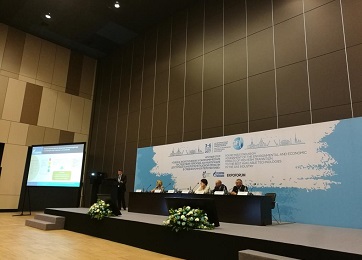
The Russian fuel and energy complex faces the challenge of ensuring rational and environmentally responsible use of energy and energy resources. The fuel and energy sector shifting to the best available technologies (BAT) procedures, provided for by Federal Law No. 219-FZ of 21 July 2014 "On Amending the Federal Law On Environmental Protection and Certain Legislative acts of the Russian Federation" will allow reducing the impact on the environment, improve energy efficiency and ensure resource-saving production. As part of the business program of the St. Petersburg International Gas Forum, experts discussed the process of transition to BAT.
Sergey Konyaev, Deputy Head of the Management, Head of the Department at Gazprom, pointed out that Gazprom takes prompt counter measures and proactive measures responding to changes in the federal legislation. For example, among the methodological documents of the corporation, in 2009, there was compiled the catalog of energy-efficient technologies. In 2015, was drawn up the register of the best available technologies ensuring environmentally safe development, preparation, transportation, storage and processing of hydrocarbon raw materials. In 2016, was adopted the Integrated Assessment of BAT Economic and Environmental Aspects Procedure and was assessed the impact of the transition to the technological standardization system based on the best available technologies for the economic performance of Gazprom. Different facilities fall into different categories of negative impact on the environment (I-IV category) in accordance with the RF Government Decree No. 1029 dated September 28, 2015. Gazprom has 353 negative environmental impact (NEI) facilities registered in the "production" and "processing" segments, including 130 (37%) first category facilities. In 2016, the design documentation of Gazprom's 507 construction projects was being prepared. An additional state expertise of 101 projects for Ist category facilities must be conducted, including 50 well construction projects. This entails a prolongation of the investment cycle for more than 7 months. Additional expenditures for each Ist category facility will amount to 2-3 million rubles. At the proposal of Mr. Konyaev, in order to improve the regulatory control of transition of Ist Category facilities to BAT, it is necessary to make a decision before 01.01.2018 in conjunction with the Ministry of Construction of the Russian Federation, representatives of business and the expert community to optimize the procedure for assessing the compliance of investment projects with environmental requirements when conducting state expertise in order to prevent a prolongation of the period of implementation of investment projects in the phased implementation of the state environmental and project design documentation expertise. Gazprom's experts think that the best way to develop regulation of NEI is a strategy of evolutionary enforcement of legal requirements and improvements of existing production technology as part of the program for reconstruction, overhaul and technical re-equipment, concluded the expert.
Natalia Pystina, Director of the Center for Environmental Safety, Energy Efficiency and Labor Protection at Gazprom VNIIGAZ, representative of the Bureau of Best Available Techniques, summed up the first results of the implementation of transition to BAT: a regulatory and methodological framework for the transition to BAT has been developed; have been registered NEI facilities, BAT technical reference documentation has been drawn up, business games have been conducted for obtaining complex ecological permits. Although, thare are still deficiencies in the regulatory and methodological framework. According to Natalia Pystina, there is no uniformity of registration, and it is possible today to begin adjusting the Engineering and Technical Service of the Best Available Technologies (the technologies rapidly become obsolete). HR and personnel training problems came to light.
Georgy Khvorov, representing Gazprom VNIIGAZ, was also lamenting over the problems expressing the opinion that there is no state regulation of the BAT transition process, but there should be stronger incentives. To illustrate the point – the question of associated gas was starting to get resolved when the state rigidly set the bar for the use at 95%. It should be the same with BAT, because their implementation is necessary not only from the point of view of economy, but also from the point of view of ecology and quality of life of Russians. Another important aspect is that BAT issues should not "live" in a frozen form: "Directories are being compiled at the present moment, but over time, literally in 5 years, the information becomes obsolete. It is necessary to introduce future-proof technologies and ensure the possibility of rapid changes in legislation".